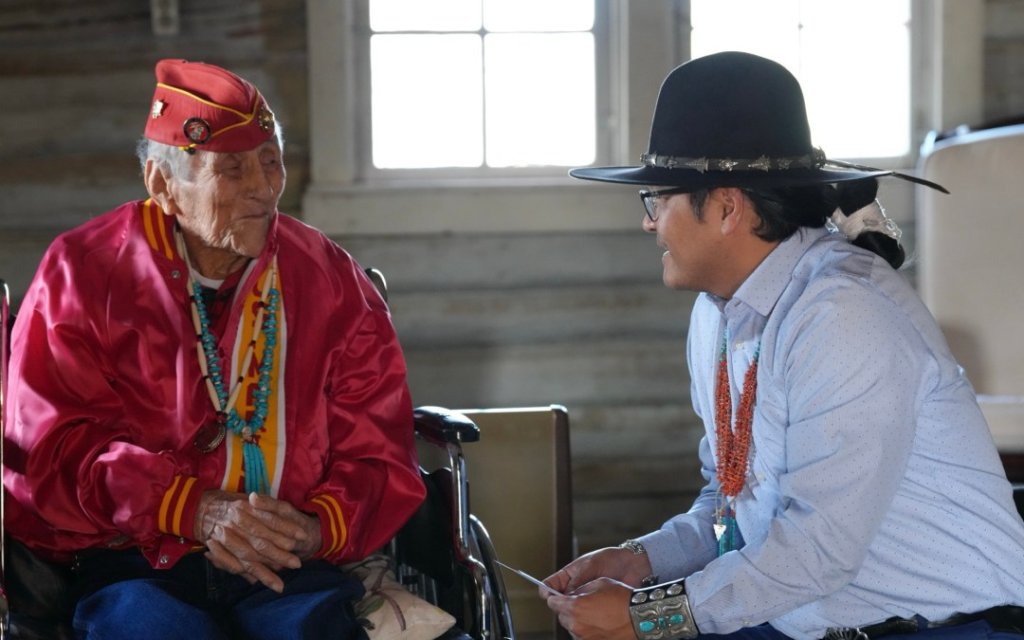During WWII, hundreds of Navajo Native Americans were recruited by the U.S. Marine Corps. Using their native Navajo Diné bizaad language, these Marines transmitted messages in a code that Japanese cryptologists were unable to break. The clandestine communication saved lives on the battlefield and was vital to success in the Pacific. Following the passing of John Kinsel, Sr. on October 19, 2024, only two Navajo Code Talkers are still alive.

According to the Navajo Times, Kinsel was born in 1917 in Cove, Arizona. After graduating high school, he enlisted in the Marine Corps on October 10, 1942. Kinsel completed boot camp at Marine Corps Recruit Depot San Diego before reporting to nearby Camp Elliott, California. There, Kinsel worked with other Navajo Marines to translate their native tongue into an unbreakable code. The Navajo for “turtle,” or “Chay-Da-Gahi,” was used for “tank.” In an interview with The Arizona Republic, Kinsel recounted that this was chosen because of the slow speed that tanks move at. In making the code, the Navajo Marines never changed their language; they only applied it creatively. “Our language was always the same,” Kinsel told The Arizona Republic.

In 1943, Kinsel was sent to New Zealand for a further eight months of training before he arrived in Guadalcanal in the Solomon Islands. He was assigned to the 3rd Marine Division’s Headquarters Regiment; Bougainville was Kinsel’s first combat campaign. In a Library of Congress interview for the Veteran History Project, Kinsel recalls the thick mud and jungle foliage on the island. Although Navajo Code Talkers were spread amongst different units, Kinsel and other Navajo Marines got together one night to cook frybread together. He also took his first dip in the ocean there, which Kinsel remembered as being cold.

After Bougainville, Kinsel served as a messenger and clerk in the regimental message center on Guam and Iwo Jima. On March 2, 1945, Kinsel and his unit ignored a warning of an impending Japanese bombing of their position on Iwo Jima. Around 11:30 that evening, Kinsel was rocked by an explosion that broke his leg. He was evacuated to Guam where he spent a few months before returning to San Diego around Christmas 1945. Kinsel was honorably discharged on January 1, 1946. When he returned home, Kinsel’s mother had a Navajo medicine man perform a ceremony for him. “He prayed for me and performed a night ceremony,” Kinsel told The Arizona Republic. “Then I returned to being a Navajo, we were given back to the Navajo.”

In 1982, President Ronald Reagan established Navajo Code Talkers Day to honor the tribe’s contribution to the war effort. It wasn’t until April 11, 1989 that Kinsel received the Purple Heart for his wound on Iwo Jima. Twelve years later, Kinsel received the Congressional Silver Medal for his service as a Navajo Code Talker. Following Kinsel’s death, Former Navajo Chairman Peter MacDonald and Thomas H. Begay are the last two living Code Talkers. “John Kinsel was not just a hero; he was a pillar of our community and a testament to the strength of our people,” Navajo Nation President Buu Nygren said in a statement. “His contributions during the war and his dedication to his family and culture will always be remembered.” Nygren ordered all fags in the Navajo Nation to be lowered to half-staff from sunrise on October 20 until sunset on October 27.


